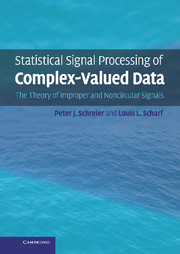Book contents
- Frontmatter
- Contents
- Preface
- Notation
- Part I Introduction
- Part II Complex random vectors
- Part III Complex random processes
- 8 Wide-sense stationary processes
- 9 Nonstationary processes
- 10 Cyclostationary processes
- Appendix 1 Rudiments of matrix analysis
- Appendix 2 Complex differential calculus (Wirtinger calculus)
- Appendix 3 Introduction to majorization
- References
- Index
10 - Cyclostationary processes
from Part III - Complex random processes
Published online by Cambridge University Press: 25 January 2011
- Frontmatter
- Contents
- Preface
- Notation
- Part I Introduction
- Part II Complex random vectors
- Part III Complex random processes
- 8 Wide-sense stationary processes
- 9 Nonstationary processes
- 10 Cyclostationary processes
- Appendix 1 Rudiments of matrix analysis
- Appendix 2 Complex differential calculus (Wirtinger calculus)
- Appendix 3 Introduction to majorization
- References
- Index
Summary
Cyclostationary processes are an important class of nonstationary processes that have periodically varying correlation properties. They can model periodic phenomena occurring in science and technology, including communications (modulation, sampling, and multiplexing), meteorology, oceanography, climatology, astronomy (rotation of the Earth and other planets), and economics (seasonality). While cyclostationarity can manifest itself in statistics of arbitrary order, we will restrict our attention to phenomena in which the second-order correlation and complementary correlation functions are periodic in their global time variable.
Our program for this chapter is as follows. In Section 10.1, we discuss the spectral properties of harmonizable cyclostationary processes. We have seen in Chapter 8 that the second-order averages of a WSS process are characterized by the power spectral density (PSD) and complementary power spectral density (C-PSD). These each correspond to a single δ-ridge (the stationary manifold) in the spectral correlation and complementary spectral correlation. Cyclostationary processes have a (possibly countably infinite) number of so-called cyclic PSDs and C-PSDs. These correspond to δ-ridges in the spectral correlation and complementary spectral correlation that are parallel to the stationary manifold. In Section 10.2, we derive the cyclic PSDs and C-PSDs of linearly modulated digital communication signals. We will see that there are two types of cyclostationarity: one related to the symbol rate, the other to impropriety and carrier modulation.
Because cyclostationary processes are spectrally correlated between different frequencies, they have spectral redundancy. This redundancy can be exploited in optimum estimation.
Information
- Type
- Chapter
- Information
- Statistical Signal Processing of Complex-Valued DataThe Theory of Improper and Noncircular Signals, pp. 250 - 269Publisher: Cambridge University PressPrint publication year: 2010
